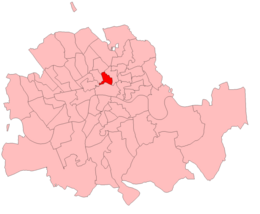Finsbury East (UK Parliament constituency) facts for kids
Quick facts for kids {{{Name}}}[[{{{Type}}} constituency]] |
|
|---|---|
| [[Image:{{{Map1}}}Constituency.svg|120px|]] [[Image:England{{{Map2}}}.svg|120px|]] |
|
| {{{Name}}} shown within [[{{{Entity}}}]], and {{{Entity}}} shown within England | |
| Created: | {{{Year}}} |
| MP: | {{{MP}}} |
| Party: | {{{Party}}} |
| Type: | House of Commons |
| County: | [[{{{County}}}]] |
| EP constituency: | [[{{{EP}}} (European Parliament constituency)|{{{EP}}}]] |
Finsbury East was a special area in North London, England, that elected one person to the House of Commons. This person was called a Member of Parliament (MP). They were chosen using a system called "first past the post," which means the candidate with the most votes wins.
Contents
History of Finsbury East
This special area, or "constituency," was created in 1885. Before that, the larger Finsbury constituency elected two MPs. Finsbury East was formed when the old Finsbury area was split up.
Finsbury East was mostly a working-class area. This means many people living there worked in factories or other jobs that paid less. Over time, more businesses and industries moved into Finsbury from the nearby city. In 1888, out of 6,140 voters, 384 did not live in the area.
Early Elections and Key Politicians
In the early years, a working man named James Rowlands was a key politician for the Liberal Party. He ran as a "Liberal-Labour candidate," meaning he was a Liberal who also had a background in trade unions.
In 1885, Rowlands lost by a very small number of votes (just 20) to a Conservative businessman named James Bigwood. But in 1886, Rowlands won! This was a big deal because many Liberal candidates lost that year. His win was important for the Liberals in London.
Rowlands won again in 1892. However, he lost in 1895 to a Conservative lawyer named Henry Richards.
Henry Richards was a "Democratic Tory." This meant he was a Conservative who believed in social reforms, like helping people with better housing and pensions for older people. He won again in 1900 and stayed an MP until he passed away in 1905.
Later Years and Liberal Dominance
After 1905, Finsbury East became a strong area for the Liberal Party. Allen Baker, a Quaker and engineer, became the Liberal MP. He had lost in 1900 but won by a large number of votes in the 1905 special election. Baker was also a representative for East Finsbury on the London County Council. He was interested in helping people and was known as an "advanced Liberal." Baker remained the MP until he passed away in 1918.
Another Liberal, Evan Cotton, became the MP for a few months in 1918. Cotton was a lawyer and journalist who had strong connections to India, where he was born. He also served on the London County Council for East Finsbury.
Finsbury East stopped being a separate constituency in 1918. It became part of a new, single Finsbury constituency.
Boundaries of Finsbury East
The Finsbury East constituency was created in 1885. It was part of the larger parliamentary borough of Finsbury, which was in the historic county of Middlesex. This area was located just north of the City of London.
The constituency included specific areas like the Parishes of St Luke Middlesex, St Sepulchre, Middlesex, Charter House, and Glasshouse Yard.
Finsbury East was surrounded by other constituencies:
- Holborn to the southwest
- Finsbury Central to the northwest
- Islington South to the north
- Hoxton to the west
- The City of London to the south
In 1889, Finsbury became part of the new County of London for administrative reasons. Later, in 1900, local government in London was changed. The old local boards were replaced by the Metropolitan Borough of Finsbury. These changes did not affect the parliamentary boundaries until 1918, when Finsbury East was abolished.
Members of Parliament
Here are the people who represented Finsbury East in the House of Commons:
| Election | Member | Party | |
|---|---|---|---|
| 1885 | James Bigwood | Conservative | |
| 1886 | James Rowlands | Liberal | |
| 1895 | Henry Charles Richards | Conservative | |
| 1905 | Allen Baker | Liberal | |
| 1918 | Evan Cotton | Liberal | |
| 1918 | constituency abolished: see Finsbury | ||
London County Council
The same areas used for parliamentary elections in London were also used to elect members to the London County Council (LCC). The Progressive Party on the LCC was similar to the Liberal Party in national politics. The Moderates, later called the Municipal Reform Party, were like the national Conservative Party.
It's interesting to note that Lord Rosebery, who later became Prime Minister, represented this area on the LCC from 1892 to 1895.
East Finsbury County Councillors
Here are some of the people who represented East Finsbury on the London County Council:
| Year | Until | Member | Party | |
|---|---|---|---|---|
| 1889 | 1898 | John Benn | Progressive | |
| 1889 | 1892 | John Sinclair | Progressive | |
| 1892 | 1895 | Archibald Primrose | Progressive | |
| 1895 | 1907 | Allen Baker | Progressive | |
| 1898 | 1904 | Joseph Benson | Progressive | |
| 1904 | 1907 | Edmund Harvey | Progressive | |
| 1907 | 1910 | E. Howes | Municipal Reform | |
| 1907 | 1910 | Alfred Welby | Municipal Reform | |
| 1910 | 1919 | Evan Cotton | Progressive | |
| 1910 | 1919 | George Gillett | Labour | |
| 1919 | constituency abolished | |||
Images for kids









